California Safe Soil graciously hosted attendees of the 2017 Green Sports Alliance Summit for a tour at their processing facility located outside of Sacramento. Founder of California Safe Soil Dan Morash walked us through the operational and logistics considerations for their food waste recycling solution, which produces an organic liquid fertilizer. Currently, most of California Safe Soil’s feedstock is commercial food waste procured from grocery stores, which on average produce 600 lbs. of fruit and vegetable waste every day.
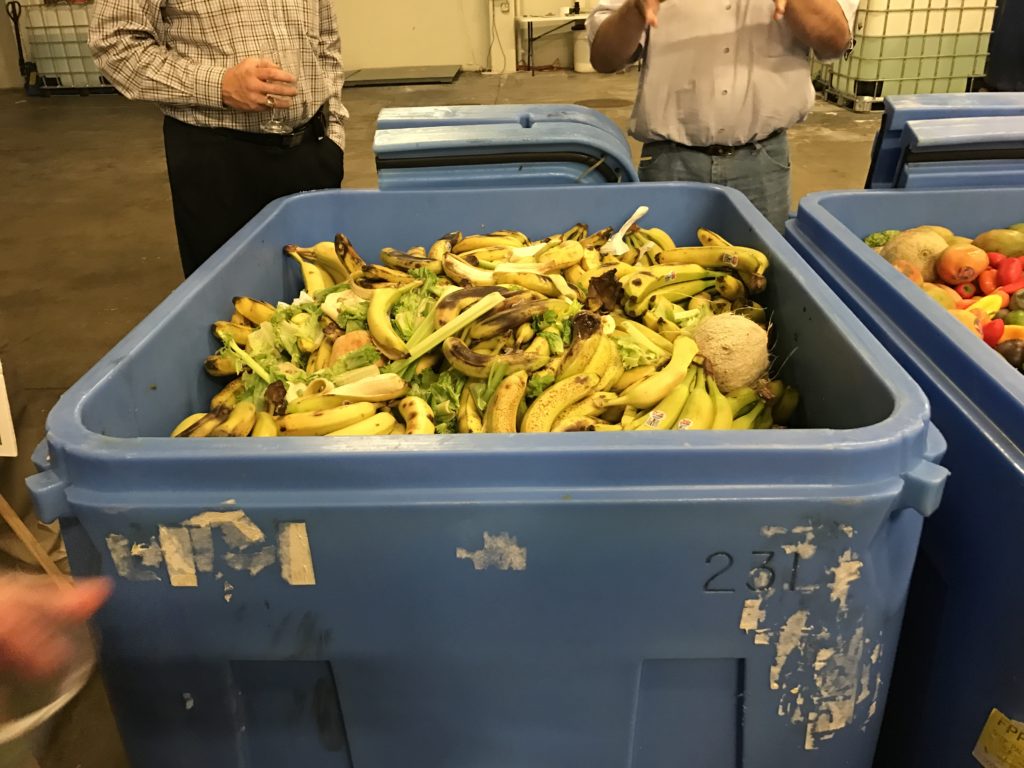 Incoming loads of food waste from local grocery stores are delivered in blue plastic totes each containing 850-900 lbs. Incoming material can include meat and seafood, but is largely comprised of damaged or overripe fruit and vegetables, or produce trimmings from food preparation. Since totes are transported from the grocery stores to California Safe Soil’s facility every other day, food does not begin to decompose, eliminating many operator and owner concerns about smell or vermin.
Incoming loads of food waste from local grocery stores are delivered in blue plastic totes each containing 850-900 lbs. Incoming material can include meat and seafood, but is largely comprised of damaged or overripe fruit and vegetables, or produce trimmings from food preparation. Since totes are transported from the grocery stores to California Safe Soil’s facility every other day, food does not begin to decompose, eliminating many operator and owner concerns about smell or vermin.
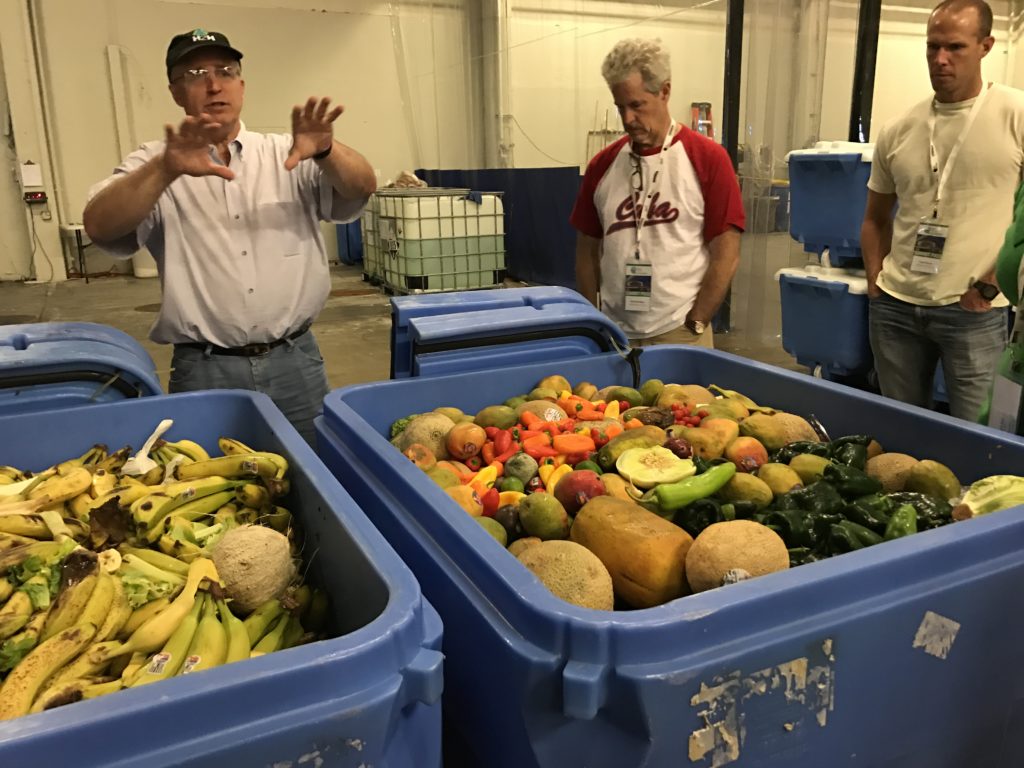 Dan Morash, Founder of California Safe Soil explains that incoming food waste will go through three major phases of processing before sale as liquid fertilizer: digestion, pasteurization, and stabilization. Each batch can accommodate 24,000 lbs of food waste and California Safe Soil can produce up to three batches a day if operating at full capacity. The final fertilizer product is transported in a liquid tank truck to a distributor and then brought to farms throughout coastal California and California’s Central Valley.
Dan Morash, Founder of California Safe Soil explains that incoming food waste will go through three major phases of processing before sale as liquid fertilizer: digestion, pasteurization, and stabilization. Each batch can accommodate 24,000 lbs of food waste and California Safe Soil can produce up to three batches a day if operating at full capacity. The final fertilizer product is transported in a liquid tank truck to a distributor and then brought to farms throughout coastal California and California’s Central Valley.
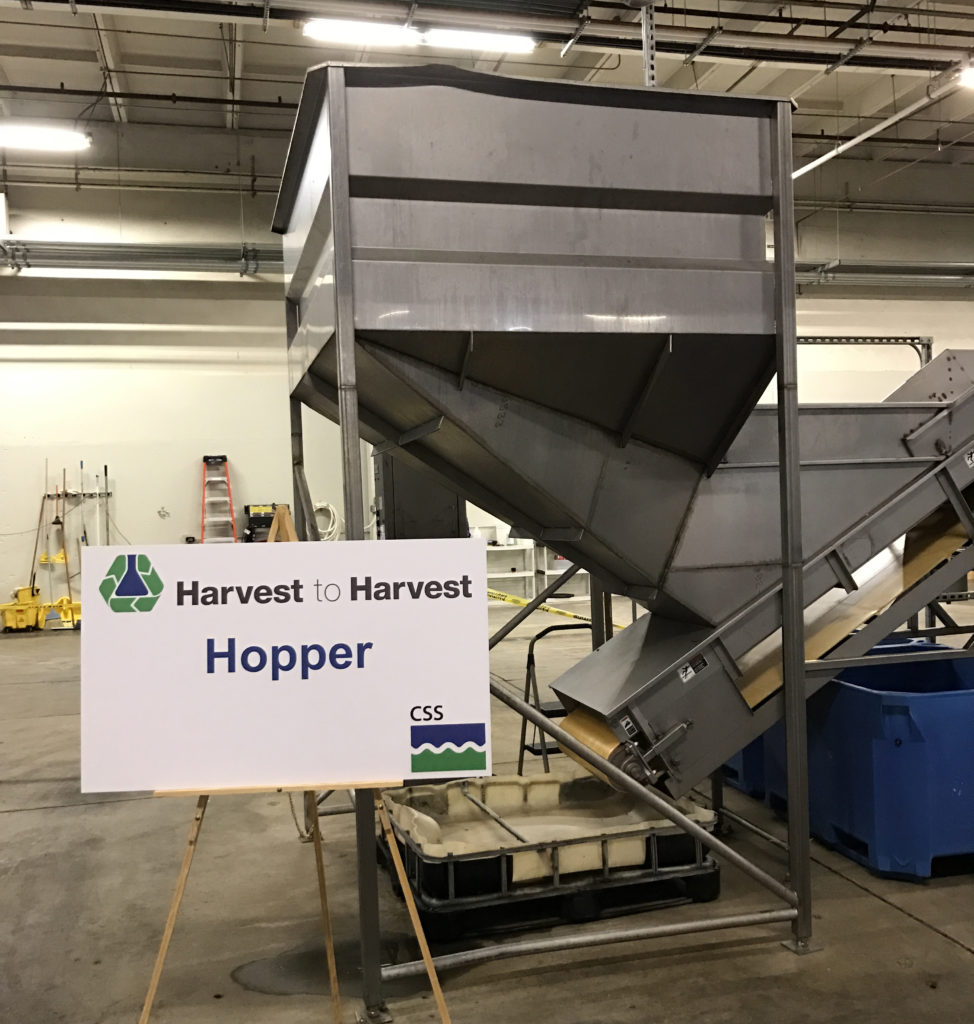 Incoming food waste is deposited in the hopper, where material is distributed evenly onto a sorting line.
Incoming food waste is deposited in the hopper, where material is distributed evenly onto a sorting line.
 Rigid and flexible plastics that are mixed in with the food are removed by hand as they are loaded into the hopper and funneled into the sorting line.
Rigid and flexible plastics that are mixed in with the food are removed by hand as they are loaded into the hopper and funneled into the sorting line.
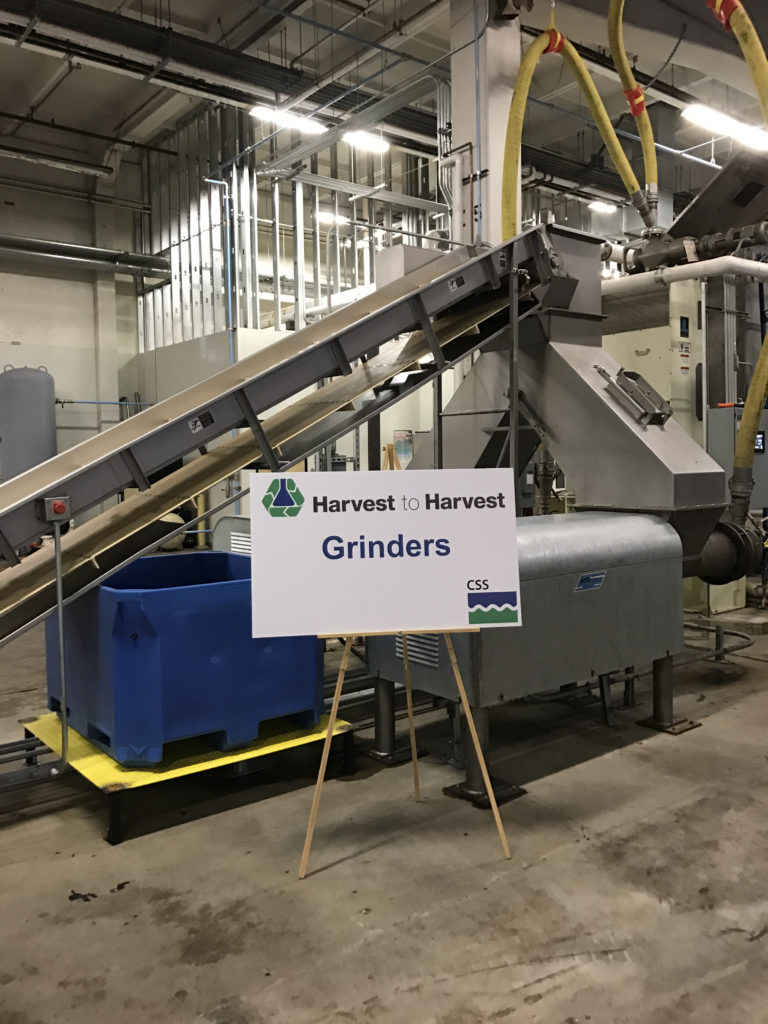 Grinders prepare incoming fruit, vegetables, and other food to be digested. Crushing food into smaller pieces, the grinders ensure streams are as consistent as possible by grinding to half an inch.
Grinders prepare incoming fruit, vegetables, and other food to be digested. Crushing food into smaller pieces, the grinders ensure streams are as consistent as possible by grinding to half an inch.
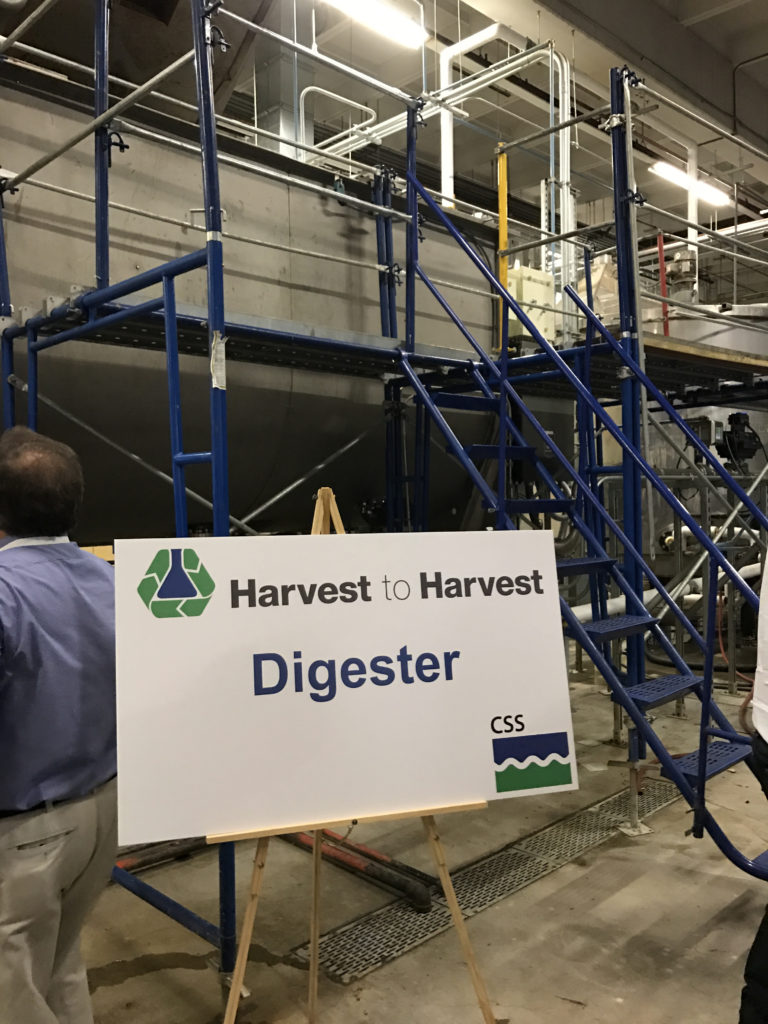
The digester receives a uniform slurry of food waste, which is heated to 130 degrees to process pectin. The biochemical reaction uses enzymes and heat to break down fibers and composition of the material. After processing, about 80% of the material is fructose or glucose.
 Once digested, material is passed through a series of screens. Here, any labels or stickers that tagged along with produce through grinding and digestion will be screened out.
Once digested, material is passed through a series of screens. Here, any labels or stickers that tagged along with produce through grinding and digestion will be screened out.
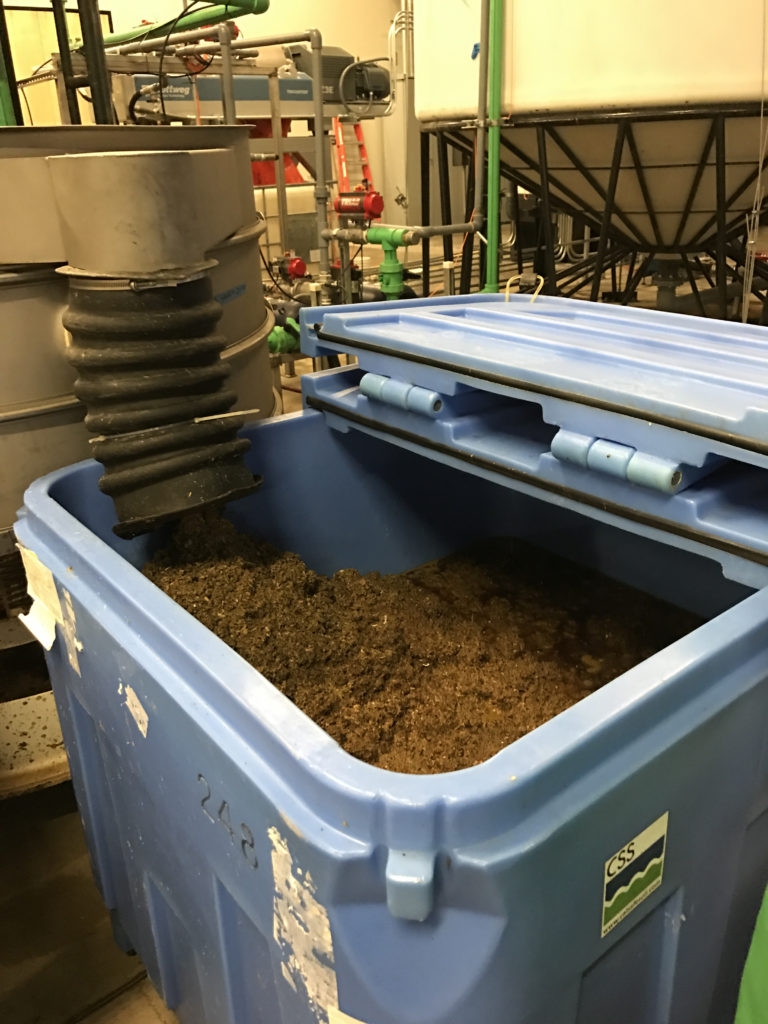 Once passed through coarse and fine screens, the remaining solids are sold as pig feed. Following the waste hierarchy to feed animals before recycling food, pigs are nourished and reliance on foreign soy imports for hog feed is diminished.
Once passed through coarse and fine screens, the remaining solids are sold as pig feed. Following the waste hierarchy to feed animals before recycling food, pigs are nourished and reliance on foreign soy imports for hog feed is diminished.
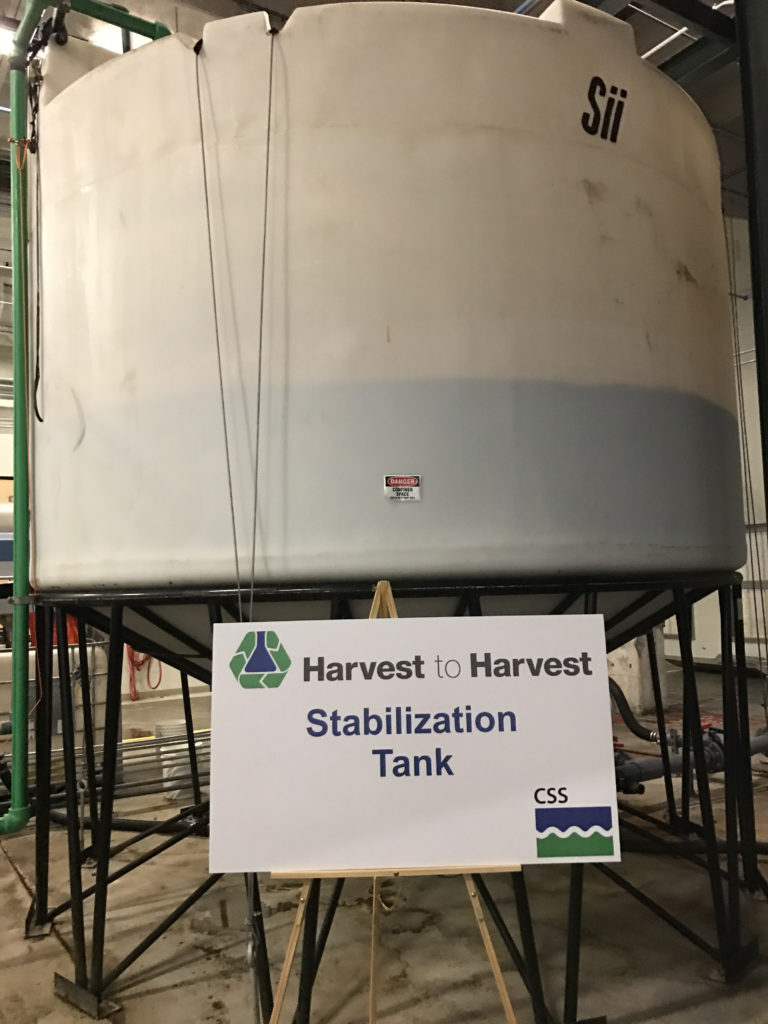 Lastly, before the liquid fertilizer is ready for field-application, it goes through a period of pasteurization for 30 minutes at 160 degrees and a period of stabilization.
Lastly, before the liquid fertilizer is ready for field-application, it goes through a period of pasteurization for 30 minutes at 160 degrees and a period of stabilization.

With the facility zoned as a rendering operation and suitable for siting in a dense urban area, transportation of food waste from groceries to California Safe Soil is convenient and not burdensome. After two years in a pilot phase in a different area of Sacramento, California Safe Soil has been succeeding in providing a waste diversion service and producing an agricultural product for the wider Sacramento area in their current facility for the past year. With eyes on the East Coast, California Safe Soil will be building a facility in New Jersey, providing the Garden State with a second option to recycle food waste with only one composting facility permitted to receive food waste in the entire state. With less demand for hog feed in New Jersey, California Safe Soil will instead produce a ratio of 80% liquid fertilizer and 20% nutrient-dense material suitable for dog food.
Category: Recover More
Don’t let it go to waste
Americans generate 65 million tons of food waste annually. Could compostable packaging aid in recovering significant amounts of food scraps for composting?
Composting may seem like a new phenomenon, but commercial composting operations have been in business in the United States since the late 1980s. While many people are familiar with backyard composting — collecting kitchen food scraps to be composted in one’s backyard or setting yard trimmings curbside to be composted by municipalities; modern composting operations are more complex. There are nearly 140 active commercial composting facilities in the United States producing rich soil amendments (the end product from the composting process). These facilities process a variety of compostable items, such as yard trimmings, food scraps, and packaging.
 Still in its infancy, commercial composting is growing rapidly, due to the U.S. Environmental Protection Agency’s (EPA) goal to reduce food waste nationally by 50% by 2030 from a 2010 baseline. A study commissioned by ReFed, a non–profit organization, analyzed the best opportunities to reduce food waste in the U.S. Their groundbreaking report determined that centralized composting was the best option, surpassing 26 other solutions to food waste management when comparing waste diversion and emissions reduced.
Still in its infancy, commercial composting is growing rapidly, due to the U.S. Environmental Protection Agency’s (EPA) goal to reduce food waste nationally by 50% by 2030 from a 2010 baseline. A study commissioned by ReFed, a non–profit organization, analyzed the best opportunities to reduce food waste in the U.S. Their groundbreaking report determined that centralized composting was the best option, surpassing 26 other solutions to food waste management when comparing waste diversion and emissions reduced.
In areas with centralized composting facilities, challenges still exist. Many composters do not accept compostable packaging, claiming to only want the “good stuff,” also referred to as pre-consumer food scraps (pictured right). Composting facilities will often refrain from collecting post-consumer food scraps and compostable packaging because they believe it will lead to greater levels of contamination. Such contamination can complicate the composting process as non-compostable items will not adequately break down within the commonly used covered aerated static pile system. But refusing to collect compostable packaging might be costing composters a sizable source of food scraps.
There is some anecdotal evidence to support the hypothesis that compostable foodservice packaging significantly increases food scrap diversion. However, few controlled studies have been conducted to specifically measure a relationship between compostable foodservice packaging and food scraps diversion.
The Sustainable Packaging Coalition conducted a study in 2016 to explore how and if compostable packaging can increase food waste diversion rates; bringing more food waste to composters. The study determined the proportion of food to packaging in front-of house areas, as well as how much food was captured in both back-of-house and front-of house areas.
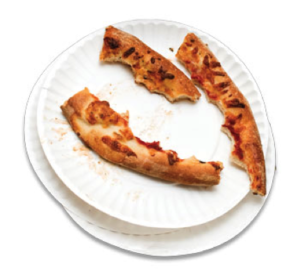 The SPC conducted waste characterizations at five venues, and the results were striking. It was found that compostable packaging could achieve a food scrap capture rate of 35-86% in front-of house areas. Oftentimes, composters do not collect food scraps from front-of house areas due to the possibility of contamination by the public. But at the largest music venue in the study, FarmAid at Jiffy Lube Live Pavilion, all the packaging was compostable, but less than half of the total amount of food scraps were generated in back-of-house areas. Therefore it was determined that packaging served as a vehicle to bring front-of house food to the compostables bin. The study did not account for contamination, the data captured the max capacity for food scrap capture in an ideal environment, in which all waste materials were sorted properly.
The SPC conducted waste characterizations at five venues, and the results were striking. It was found that compostable packaging could achieve a food scrap capture rate of 35-86% in front-of house areas. Oftentimes, composters do not collect food scraps from front-of house areas due to the possibility of contamination by the public. But at the largest music venue in the study, FarmAid at Jiffy Lube Live Pavilion, all the packaging was compostable, but less than half of the total amount of food scraps were generated in back-of-house areas. Therefore it was determined that packaging served as a vehicle to bring front-of house food to the compostables bin. The study did not account for contamination, the data captured the max capacity for food scrap capture in an ideal environment, in which all waste materials were sorted properly.
Composters are reasonable to fear that collection of front-of-house food scraps can lead to small amounts of contamination, and ultimately lead to costly decontamination processes. Many composters are unwilling to jeopardize the quality of their soil amendment, which often represents the bulk of their revenue. The SPC hopes this study will show composters the potential gains from allowing more packaging into their collection streams. The significant increases in food capture will help offset the cost of decontamination, and ultimately help consumers become more aware and engaged in composting efforts. This is only the start of the conversations with composters, and serves as the beginning for re-evaluating compostable packaging as an asset, not a determent to the compost industry.
Compostable packaging will play a significant role in achieving the EPA’s food waste reduction goal. While 7% of composters already accept compostable packaging, wider adoption is needed to divert additional material. With proper labeling on packaging through the new How2Compost label, contamination can be reduced.
Stay tuned for the release of the SPC’s full Value of Compostable Packaging report later this month.
Building up trust in recycling
It has taken decades to build up a culture and an infrastructure to support recycling in the United States. Every Tuesday like clockwork, my neighbors line up their blue carts of recycling next to their green carts of trash. For many people, recycling is as easy as filling up your cart and wheeling it to the curb. Unfortunately this isn’t the case for everyone. Some people have community drop-off sites for recycling and some have no access to recycling at all. Even in those communities where recycling is available, we don’t all have the ability to recycle the same types of products, creating confusion. So how do we know if the work done by all of our recycling leaders to create a recycling system in the United States has been successful and if it’s sustainable?
The panel on Building Trust in Recycling at SustPack 2017, which included panelists Derric Brown of Evergreen Packaging, Keefe Harrison of The Recycling Partnership, and Susan Robinson of Waste Management, tackled this and other questions about the current status and the future of recycling. As the panelists discussed, recycling isn’t easy. While brands and retailers have well-organized distribution systems to supply consumers with products, recycling is essentially returning those materials back to the marketplace through reverse logistics using a complex chain of 20,000 different local governments, over 200 material recovery facilities, and untold numbers of reprocessors and end markets. Creating a system in which all of these different entities can work together takes a lot of effort.

So how do we know if the recycling system is working? Traditionally, local governments have measured their recycling programs using weight, specifically, the tons of material diverted from the landfill. This measurement is easy to collect and makes sense to residents. As mentioned by the panel, another option is to use life cycle assessments (LCAs) as a way to measure the success of recycling. An LCA is a model that assesses the environmental impacts of a product or package from raw material extraction through disposal or recycling.
LCAs are complicated. A number of different pieces of data go into them, and the user can set up the parameters of each LCA differently. The outcomes of an LCA, like the eutrophication potential of a product, can be esoteric to the average consumer. As one panelist said, it would be hard to explain an LCA for recycling to residents. The outcome of an LCA depends on the data and parameters used to complete the model, making the results of one LCA difficult to compare to the results of someone else’s LCA.
While LCAs may be a valuable tool to help understand the carbon impacts of products, they should not be the sole measurement tool for solid waste management. LCAs can be used in addition to the measures already available to us, such as weight-based measures of landfill diversion, as well as waste characterization studies and measures of how much of our recyclable materials make it to the recycling cart instead of the trash cart.
So while we’re not yet able to measure the success of recycling with a single metric, what the recycling system does have going for it is that consumers really want it to work – they want to recycle and they expect to be able to recycle easily, both at home and away from home. As one panelist mentioned, when a material is removed from their recycling mix, they feel a sense of betrayal. When word spread in my community that glass might be ending up at the landfill after going to the MRF, my neighbors took to our neighborhood listserv to express their frustration that they were taking the time to recycle glass but it was not actually being recycled. But others wanted to find ways to keep recycling glass, like taking it to drop-off sites. Because people know that recycling benefits the environment, and they want to contribute.
We should continue to discuss how to measure the success of recycling, including how best to use landfill diversion, capture rates, and LCAs to understand our impacts. But we should also keep in mind the less measurable impacts of recycling, such as empowering consumers to take action that benefits the environment.

For those of us working in the sustainable materials management space, we’ve understood for a long time that plastic pollution in the world’s oceans has been a serious problem.
But, for many, the concern reached a zenith when the World Economic Forum shed light on the projection that by weight, there will be more plastic in our oceans than fish by 2050 in the New Plastics Economy Report. With a little over a year since publication, a flurry of activity has surfaced among consumer packaged goods (CPG) companies involving ocean plastic. CPGs have developed numerous initiatives to both source recovered ocean plastic as an input for packaging and several apparel companies have engineered ways of using ocean plastic in textiles for clothing and shoes. Both are strategies that have important challenges worthy of examination, but also show multinational companies are interpreting circular economy principles in new and more diverse ways.
 Parley for the Oceans is one organization that has served as a bridge from stakeholders concerned with threats to marine biodiversity and conservation to the private sector, responsible for both generating plastic material that escapes into the environment and providing demand for recovered ocean plastic as an input for new products and packaging. One recent partnership has been between Parley for the Oceans and Adidas, where they designed the Adidas UltraBOOST Uncaged shoe made with a knitted upper comprised of 95% recovered ocean plastic and 5% recycled polyester. While the first 7,000 units were released on November 15, 2016, Adidas Group Executive Board member Eric Liedtke explains that, “We will make one million pairs of shoes using Parley Ocean Plastic in 2017 – and our ultimate ambition is to eliminate virgin plastic from our supply chain.”
Parley for the Oceans is one organization that has served as a bridge from stakeholders concerned with threats to marine biodiversity and conservation to the private sector, responsible for both generating plastic material that escapes into the environment and providing demand for recovered ocean plastic as an input for new products and packaging. One recent partnership has been between Parley for the Oceans and Adidas, where they designed the Adidas UltraBOOST Uncaged shoe made with a knitted upper comprised of 95% recovered ocean plastic and 5% recycled polyester. While the first 7,000 units were released on November 15, 2016, Adidas Group Executive Board member Eric Liedtke explains that, “We will make one million pairs of shoes using Parley Ocean Plastic in 2017 – and our ultimate ambition is to eliminate virgin plastic from our supply chain.”
But Adidas isn’t limiting recovered ocean plastic as a feedstock material for footwear, they also worked with Parley to create the first jerseys made of 100% ocean plastic for football teams Real Madrid and Bayern Munich. Munich player Xabi Alonso (left, in red) highlighted that, “Wearing a [jersey] that is made from recyclable ocean waste is something I’m very happy about as it’s a fantastic opportunity to raise awareness about the need to protect and preserve our oceans.”
Indeed, raising awareness about sustainability in general and ocean plastic pollution specifically is a chief benefit of using recovered ocean plastic in new products and packaging. Method – People Against Dirty was one of the first companies to use recovered ocean plastic in their soap bottles in 2012 and highlighted the importance that social awareness was to their packaging design. Parham Yididsion of Envision Plastics, Method’s recycling partner, explained that it was a project where they could actually make a difference and make a point. This emphasis on awareness and activism emerges in Method founder Adam Lowry’s discussion of the project as well. He elaborates that, “We know that only a small amount of plastic will be taken out of the ocean through all of these bottles. We know that’s not the solution. But, we also know that we can have a much bigger impact if we start to change people’s mind about their role in protecting our oceans.”

Much like Method’s conventional soap bottles that use 100% post-consumer recycled polyethylene terephthalate (PET), the ocean plastic bottles designed out the need for virgin plastic, reducing the carbon footprint by 70%. Since Method first broke ground in sourcing ocean plastic to produce plastic bottles, the industry has been innovating to increase the percent of ocean plastic in a given resin mix.
Procter & Gamble, for example, is releasing a limited run of Head & Shoulders shampoo bottles this summer in France at Carrefour stores. P&G’s black high-density polyethylene (HDPE) is unique in that unlike many other ocean plastic packages, they’ve worked to sort-out other polymers from the beach plastic that it sources. In addition, P&G has raised the proportion of ocean plastic in the formulation up to 25%. More generally, the CPG company announced that by the end of 2018, it will have half a billion packages in Europe with at least 25% post-consumer recycled content, among its hair care portfolio including Head & Shoulders and Pantene.
One downside to packaging that employs recovered ocean plastic is that the plastic’s color often results in a dark grey when processed. From this point, many companies will then use dark or black colorants to make the package appear more uniform and provide more juxtaposition with competition on-shelf. When on the sorting line at a MRF however, this results in near-infrared (NIR) sorting technology not being able to distinguish between black polymer types. The Association of Plastic Recyclers (APR) illuminates in their authoritative Design Guide that, “There is no mechanical property inherent in black HDPE that makes it unrecyclable. The problem lies in sorting and the physics behind polymer identification.” The same NIR sorting challenges affect black PET, but unlike HDPE, opaque colored PET does not have an end market even if sorting challenges were overcome.
 Another challenge that P&G’s Vice President for Global Sustainability Virginia Helias highlights is the limited quantity of beach plastic and much higher expense due to the complex supply chain of its collection and processing. Critics of ocean plastic use in plastic packaging will point out that this elaborate supply chain also likely means that the environmental toll of transport involved negates some of the benefit to the material recovery. Yet, conservationists are quick to counter that if the material is being collected by volunteers from beaches or waterways already, a second-life as a package or textile is certainly a better outcome than a landfill or incinerator.
Another challenge that P&G’s Vice President for Global Sustainability Virginia Helias highlights is the limited quantity of beach plastic and much higher expense due to the complex supply chain of its collection and processing. Critics of ocean plastic use in plastic packaging will point out that this elaborate supply chain also likely means that the environmental toll of transport involved negates some of the benefit to the material recovery. Yet, conservationists are quick to counter that if the material is being collected by volunteers from beaches or waterways already, a second-life as a package or textile is certainly a better outcome than a landfill or incinerator.
Nevertheless, companies like Adidas using recovered ocean plastic in large quantities incentivize efforts to continue removing plastic from the ocean as they help to coalesce a reliable end market for the material. Dell, which is using 25% ocean plastic in its 100% post-consumer recycled content laptop trays, stress that this is a deliberate aspect to their sustainability initiatives. Dell describes the initiative as the“first commercial-scale global ocean plastics supply chain.” Moreover, the computer technology company, “will convene a working group to address ocean plastics at scale.” In due course, more companies will likely continue to incorporate ocean plastic as a feedstock once a reliable and larger stream of plastic is being recovered from waterways. As Parley for the Oceans Founder Cyrill Gutsch clarifies, “At this point, it’s no longer just about raising awareness.”
No matter where you stand on the issue today, be sure to engage in the conversation during the Sustainable Packaging Coalition’s next Open Forum on March 23rd from 1-2pm EST. Joi Danielson from the Ocean Conservancy and Procter & Gamble’s Jack McAneny will be shedding light on their work in the ocean plastics space. Learn more and register HERE.
To rinse or not to rinse
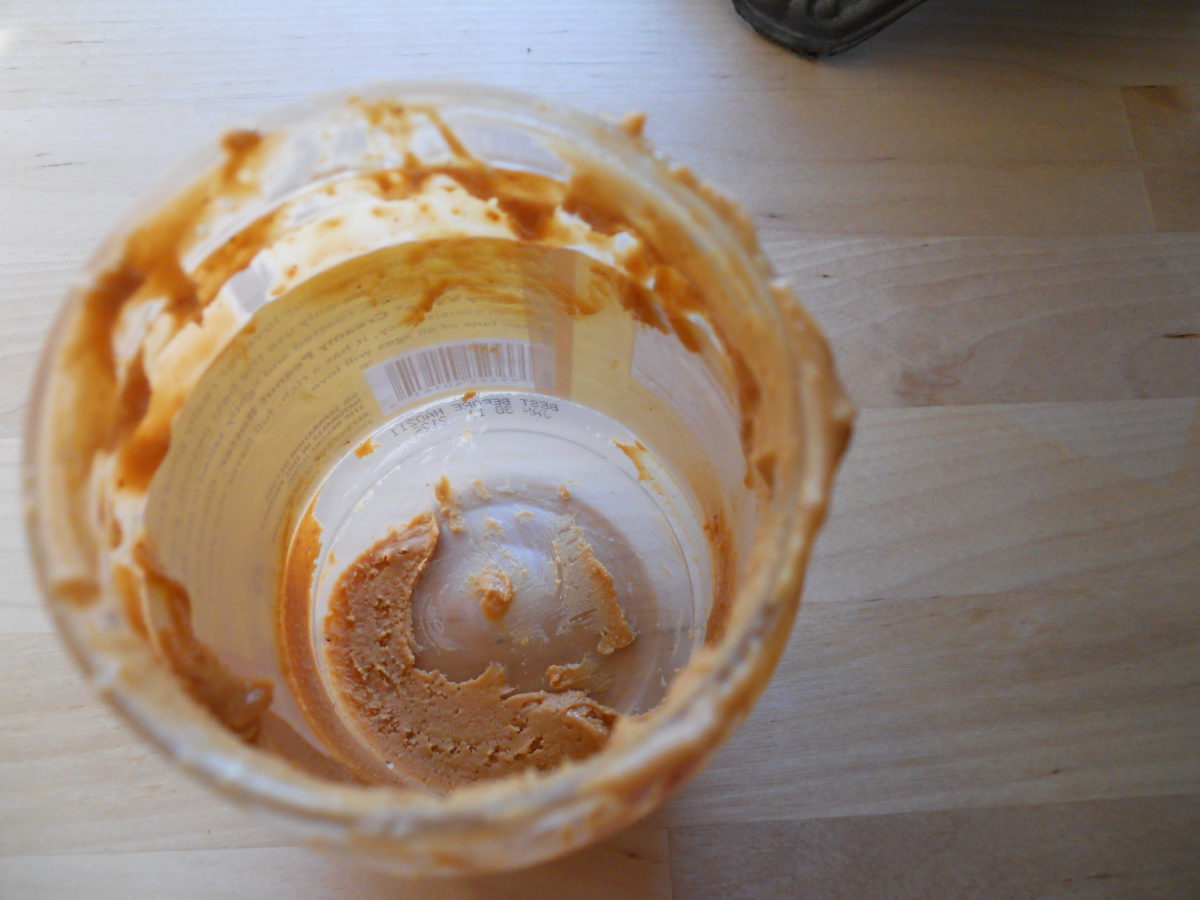
It is important to properly prepare packaging for recycling in order to optimize the quality of recycled materials, but it can sometimes be confusing. How exactly do we know when it’s necessary to rinse our packaging and when it is more valuable to conserve water?
Determining whether rinsing packaging is necessary depends on a few factors, including how much residue is left, what was in the container, and whether the closure even allows you to easily rinse the inside of the container?
 Here are a few guidelines:
Here are a few guidelines:
- If you are making sure that every container is empty before recycling it, you’ve gone most of the way towards being an excellent recycler. Packaging that is still full or partially full is at high risk of being landfilled even if you place it in your recycling bin. You should compost any remaining crumbs or unused food products before recycling.
- Any package containing a lot of thick and sticky residue, like a jar of peanut butter or a tub of icing, should be rinsed.
- Any package containing soap (dishwasher detergent, shampoo, laundry detergent, hand soap, etc.) should not be rinsed. In fact, some plastic recyclers rely on residual soap to clean the plastics during reprocessing. After all, it is important to reduce, reuse, and recycle!
- Rinsing does not need to be perfect. Don’t worry about getting every single spot of residue off, because that uses a lot of water. Just splash that salsa jar with a little water, replace the lid, and it’s ready to go.
- If the cap or lid isn’t easily removed for you to get inside it and rinse, don’t worry; just make sure the package is thoroughly empty before recycling.
Look for the How2Recycle label that explains when a container should be rinsed or not. When in doubt, use your best judgment: a high quality, low contaminant recycling stream is important, but so is water conservation.
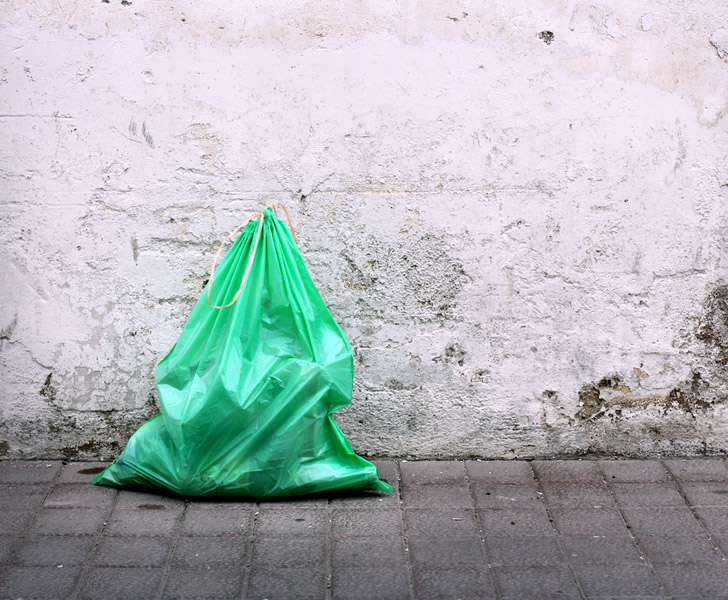
Seattle says non-compostable plastic bags cannot be colored green or brown any longer in an aim to reduce confusion
On Monday, October 3rd Seattle’s passed a new measure prohibiting non-compostable bags to be tinted green or brown. This is a groundbreaking development in the quest to clarify end-of-use options for packaging and create harmonization of compostable labeling practices.
 Non-compostable plastic bags that are tinted green, mostly used in produce and carry-out bags, are often used in an attempt to connect the green color with a green message. Unfortunately, these items, as Seattle has found, pollute the local compost. When plastic bags are put in compost, they not only produce unsightly litter at the compost facility, they can also produce macro and micro fragments when they begin to break down that contaminate the finished compost.
Non-compostable plastic bags that are tinted green, mostly used in produce and carry-out bags, are often used in an attempt to connect the green color with a green message. Unfortunately, these items, as Seattle has found, pollute the local compost. When plastic bags are put in compost, they not only produce unsightly litter at the compost facility, they can also produce macro and micro fragments when they begin to break down that contaminate the finished compost.
Polyethylene bags are accepted at many retail locations for recycling, and recovery of these valuable materials remains important. However, not only does a green tint make the bags more likely to be mistaken for compostable, but also misleading language, terms such as “biodegradable,” or “degradable” and “decomposable” further confuse the messaging. Seattle’s forward-thinking new ordinance will eliminate these practices that contribute to the problem of contaminated compost that increases costs and lowers the value of finished compost.
The How2Recycle label website helps clarify the differences between compostable and recyclable. Recently, GreenBlue launched the How2Compost label, an on-package label that verifies that packaging is certified compostable. The label design includes the BPI logo and a link to a website with additional information.. Compostable bags can use the How2Compost Label and be tinted green or brown, while non-compostable bags can use the How2Recycle “Store Drop-Off” label and ideally be clear or another color not easily confused with compostables. Seattle’s new law will move the country in the right direction!
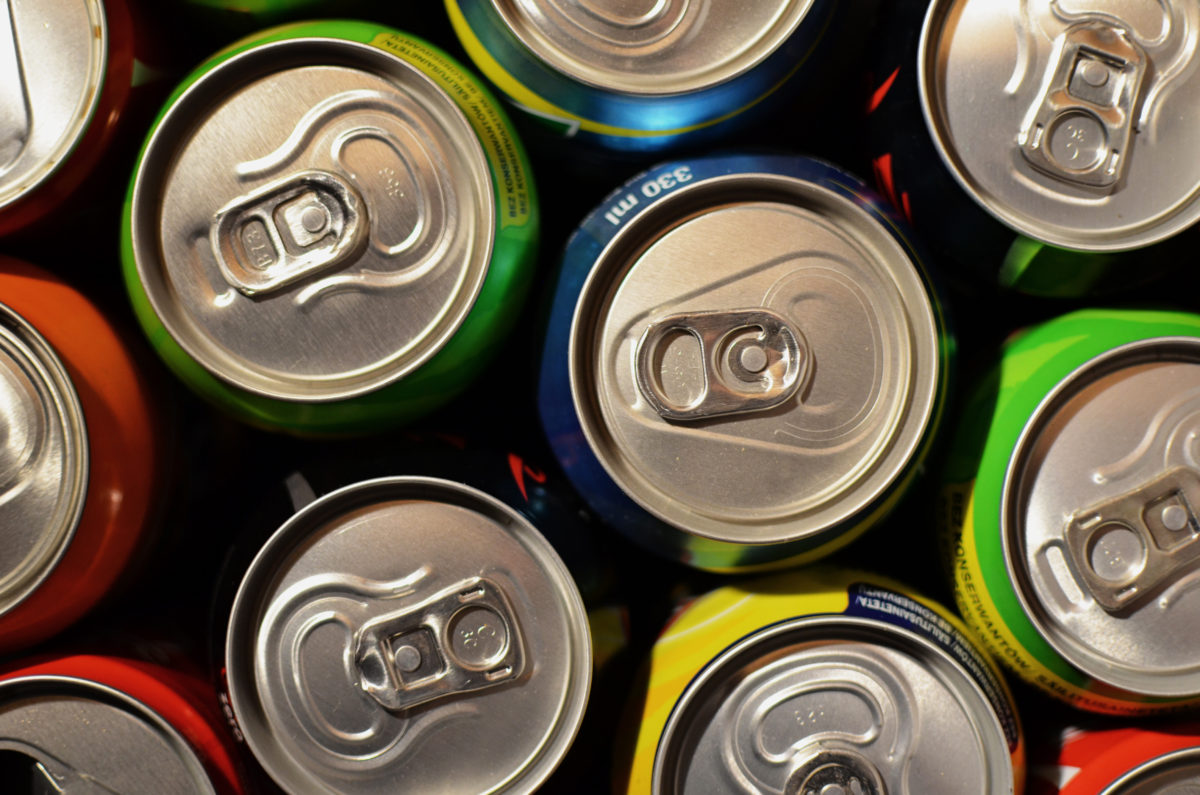
This article originally was published in Packaging Digest Magazine
Recycling programs do their best to communicate the items they want to collect. They should do better.
That’s one of many conclusions we’ve drawn from our soon-to-be-released Centralized Study on Availability of Recycling. The study examined recycling programs in more than 2,000 communities across the United States andgathered a yes/no for the acceptance of nearly 50 types of packaging and containers. For many of the packaging types studied, that yes/no determination is straightforward. For many other types of packaging, however, it is not.
This is something that can, and must, be improved.
This type of national study of recycling programs can be conducted from two angles. Angle one is behind the scenes, learning from program administrators which items the program intends to collect. Angle two is from the eye of the public, examining the recycling collection instructions and guidance offered by the recycling program and seeking a mention of each item under the “accepted” or “prohibited” headers. Our study used the latter methodology. This data serves to substantiate consumer-facing claims of recyclability, so it’s most important to determine the items that the consumer understands to be accepted in their recycling programs.
Unfortunately, the recycling program instructions offered to consumers are frustratingly inconsistent. The number of phrases that are consistently used across programs can probably be counted on one hand. Newspaper. Phone books. From a strict linguistic standpoint, that’s probably it.
Even an item so ubiquitously accepted as the aluminum beverage can is not referred to with consistent wording. Beverage cans. Aluminum cans. Cans. Metal cans. Food and beverage cans. This example may sound harebrained because the average consumer should, surely, be expected to understand any of these phrases to refer to the aluminum beverage can, but think about how it muddies the waters for aerosol cans.
When a locality says they accept “aluminum cans,” does the consumer understand whether or not aluminum aerosol cans are acceptable? One step further—does the consumer know how to tell the difference between a steel aerosol and an aluminum aerosol? No, they don’t. If they read “food and beverage cans,” does this mean that aerosol cans for whipped cream and cooking spray are acceptable, while other aerosols for other types of products aren’t?
The point to be made here is that programs should be specific. If a program wants aluminum beverage cans but not aerosols, it should say “aluminum beverage cans only.” Or if that program also wants aerosol cans—and we hope this fictitious program would—then it should mention aerosol cans.
Specificity does have a limit. We operate in a world where the recyclability of packaging is much, much more nuanced than its basic material type and format. Fiber structure with polycoat on one side? Fine (probably). Polycoat on both sides? Not so recyclable. PET clamshell? Great. PET clamshell laden with adhesive? Nope.
This level of nuance cannot be conveyed to the general public. It’s tempting to think it should be, but we would be swiftly served with a reality check. For consumers to not be overwhelmed with technical nuance and overloaded with jargon, recycling programs must paint their acceptance guidelines with broad strokes. That’s okay. A lot can be communicated in broad strokes.

But they must strive to hit the right balance, being as specific as possible while also remaining conscious of the consequences of broadly stated acceptance. Some unrecyclable items will be stated as acceptable in the program. Conversely, some perfectly recyclable items will be prohibited. Many will still be plainly ambiguous. The goal is to reduce as much ambiguity as possible without plummeting terribly far in the weeds, and our study findings suggest American recycling programs have a way to go before we approach the right side of this balance.
The end result of our study is what we believe to be the most robust and comprehensive picture of the acceptance of packaging in recycling programs across America. Beside their utility to substantiate thousands, perhaps millions, of recyclability claims, the national acceptance rates calculated from this data will serve as an important baseline from which change can be measured. And the detail of the national figures will give us important insight into the specificity—and ambiguity—of recycling collection guidelines.
Now, if we initiate a concerted effort to unify and harmonize recycling program instructions, we can hope to see a decrease in ambiguity and non-mentions of recyclable packaging and an increase in our confidence of knowing what’s accepted and what’s prohibited. Our industry’s conversations around improving recycling systems tend to entail things like building new infrastructure, implementing new technologies and developing new infrastructure—all with frightening price tags and seemingly insurmountable obstacles.
The opportunity for improvement ought to be a breath of fresh air. We need to change some words. This can be done now.
Charlottesville Scales Up Composting
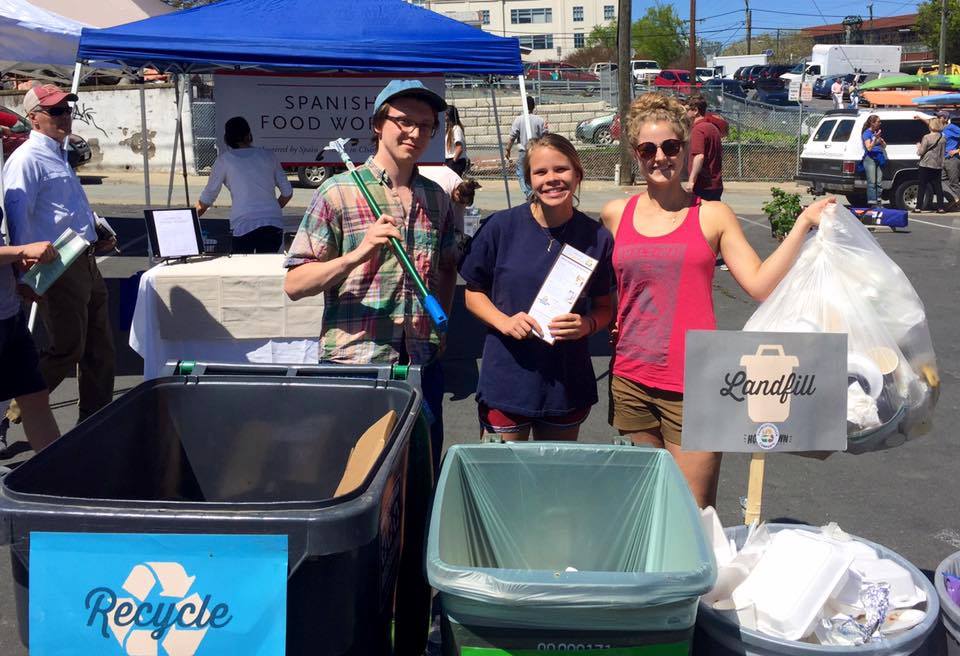
After enthusiastic public participation in the 2015 compost drop-off pilot program, composting continues in GreenBlue’s hometown of Charlottesville, Virginia in 2016.

The City Market compost drop-off in Charlottesville began as a pilot program funded by a grant from the Environmental Protection Agency (EPA) Region III. The 2015 pilot program aimed to divert compostable waste from landfills by collecting compostable material from residents and on-site at the City Market from April to October 2015. Charlottesville residents were given the opportunity to drop off their food scraps, yard waste, uncoated paper items like napkins and paper towels, and certified compostable packaging at the City Market, to be composted for free. To make it more convenient for residents, every Saturday, when residents dropped off their waste, they were provided with free compostable bags. From the resident drop-off station alone, over 6,000 pounds of household compostable material was collected, with the average participant dropping off 5.5 pounds of compostable material. In addition, market vendors participate by collecting their in-kitchen food scraps.
After participating for seven months, residents didn’t want to stop. With the City Market pilot program ending in October, residents were eager to find a winter drop-off location. After several citizens approached the Rivanna Solid Waste Authority (RSWA) about providing an interim service between market seasons, the initiative was approved. Rivanna’s McIntire Recycling Center began collecting compostables in January, expanding the program to residents of Albemarle County as well. As the Market season resumes, the McIntire Recycling Center program was scheduled to conclude at the end of April. On April 26th, the RSWA Board decided to extend the program, to offer year-round compostables collection in Charlottesville. For more information about the RSWA Board’s decision, visit rivanna.org/news-and-information/board-meetings-2.
Browse through our Charlottesville City Market composting photo gallery
The success of the previous year has galvanized composting efforts in Charlottesville. The City of Charlottesville in partnership with GreenBlue, Better World Betty, N.O.P.E., and Black Bear Composting will continue to provide a compost drop-off station at the City Market for the 2016 market season. Anxious for the return of the composting program, residents flocked to the City Market this month, and in the first 4 weeks of the season, the program has collected over 400 pounds of food scraps and compostable packaging. The City continues to record the total weight and type of compostables dropped off by participants each week to gauge interest and program growth over the market season. To view up-to-date City Market compost collection data, visit Smart Cville’s live data tracker.
Charlottesville illustrates a model small city, scaling up composting efforts among its residents. By continuing to educate residents on how they can sustainably manage their household waste, the program can only grow. The US Census Bureau estimates Charlottesville’s population to have been 45,593 in 2014. If every resident diverted just 5.5 pounds of their weekly kitchen scraps from the landfill, the City would be able to collect a total of 250,762 pounds of compostable material per week which can be used to produce valuable compost to improve the health of local soil. The future is bright for composting in Charlottesville. The City hopes to continue to build on their success by adding additional community drop-off sites and maybe one day implement a curbside pickup program.
Those interested in volunteering at the City Market can sign up here, or email Tesia at Tesia.moore@greenblue.org to learn more about volunteering.
Read the NBC 29 story about the Charlottesville City Market.

“Zero Waste.” Not too long ago that phrase seemed a lofty and unattainable idea. And yet, today many companies are increasingly finding success in diverting waste from landfills and finding the best and most efficient use for the resources. Companies publicly committing to zero waste are, in fact, becoming quite commonplace.
As companies like Toyota, Unilever, and Hershey reach their goal of sending zero waste to a landfill, it’s very likely they will begin to expect the same from upstream suppliers. In fact, as a brand owner or processor, you might have the same goals and expectations of your supply chain. Recognizing that responsibly managing material in the manufacturing phase is an increasing priority for industry, SPI launched the Zero Net Waste Program after an 18-month development process.
This program is a groundbreaking recognition program and tool that helps members decrease the impact of waste in manufacturing by evaluating waste-reducing opportunities and maximizing diversion from landfill. The ZNW program provides plastics companies a concrete set of resources they can use to pursue, and achieve, zero net waste in their facilities and offices. It also recognizes participants for these achievements once facilities demonstrate their progress.
The idea of the program came from the SPI Recycling Committee’s Emerging Trends Subcommittee, chaired by Kathy Xuan, CEO of PARC Corp, and was developed by a broad stakeholder workgroup of SPI members.
“As chair of the subcommittee and a recycler who provides zero landfill services, we feel this program will be instrumental in providing tools and resources to accelerate the industry’s pursuit of zero waste,” said Xuan.
Why Zero Net Waste?
 People will notice that SPI’s program didn’t just adopt the phrase “Zero Waste” to define the program. The phrase “zero waste”, in its purest interpretation, does not allow for diversion through energy recovery. While SPI recognizes energy recovery as a valuable solid waste management tool, we believe that energy recovery should only be used as an end-of-life management strategy for materials that cannot be mechanically recycled. For materials that cannot be mechanically recycled, we believe that responsibly recovering value through energy is the second best end-of-life management option. The SPI workgroup felt that the term “Zero Net Waste” was a better embodiment of the widely accepted “reduce, reuse, recycle, and recover” waste management hierarchy.
People will notice that SPI’s program didn’t just adopt the phrase “Zero Waste” to define the program. The phrase “zero waste”, in its purest interpretation, does not allow for diversion through energy recovery. While SPI recognizes energy recovery as a valuable solid waste management tool, we believe that energy recovery should only be used as an end-of-life management strategy for materials that cannot be mechanically recycled. For materials that cannot be mechanically recycled, we believe that responsibly recovering value through energy is the second best end-of-life management option. The SPI workgroup felt that the term “Zero Net Waste” was a better embodiment of the widely accepted “reduce, reuse, recycle, and recover” waste management hierarchy.
Guiding Members to Success
The cornerstone of the Zero Net Waste program is the manual, which includes real world, step-by-step tools and resources for companies throughout the plastics value chain to ensure that plastic materials and other byproducts of manufacturing are put to their highest and best use. From building the business case for pursuing zero net waste, to educating employees and offering practical guidance on finding the right service providers, the ZNW program manual is designed to enable companies of all sizes to take immediate steps to begin pursuing zero waste in their facilities.
Companies who participate in the program, and meet requirements of the two-step qualification and verification process will be recognized for their efforts and are allowed to use the Zero Net Waste logo. For those companies that go on to pursue third-party certification for their landfill reduction achievements, embarking on this program will align them for success in eventual certification.
“The Zero Net Waste Program isn’t just for companies looking for zero waste certification,” said Robert Flores, director of sustainability for Berry Plastics. “The accompanying manual is applicable to a wide variety of companies and provides the basics for how get started, as well as how to enhance existing programs that a company already may have in place.”
The Benefits of Zero Net Waste
There are a host of benefits that companies can enjoy from their zero net waste activities, both environmental and economic. On the environmental side, companies who reduce what they send to landfill are reducing their operational footprint. They are also being good community members by helping to extend the life of the landfill. The process of citing a new landfill once the old one reaches capacity can be an arduous process. Many communities emphasize the importance of recycling as a tool to extend the life of landfills. Through maximum diversion, our members can help communities achieve this.
The economic benefits of zero net waste can also be numerous. Many companies have not only found success dramatically cutting their garbage and landfill costs, but in some cases, are generating revenue from the sale of scrap materials. Other companies are using their landfill diversion success as a green marketing opportunity and market differentiator. This can translate to strengthening customer relationships and generating new business. In addition, companies that make sustainability initiatives a priority report higher, on average, levels of employee satisfaction and retention. People like working for companies that they feel are good stewards of their communities and the environment. This is a particular priority for millennials entering the workforce today.
The Right Direction For the Plastics Industry
Lastly, zero net waste efforts fit in with larger waste management goals nationally and globally. Calls for meaningful change in the way our industry manages our products throughout their life cycle have been building, reaching a crescendo recently at the World Economic Forum meeting in Davos earlier this year. During that meeting, the Ellen MacArthur Foundation released the report “The New Plastics Economy – Rethinking the Future of Plastics”, which contended that by 2050, the world’s oceans will have more plastic than fish, by weight. The report calls for “a shared sense of direction, to spark a wave of innovation and to move the plastics value chain into a positive spiral of value capture, stronger economics, and better environmental outcomes.”
This move toward a circular economy and sustainable material management (SMM) thinking is very much in line with SPI values and the reason why SPI has developed the ZNW program.
“These are values being driven by many of the major brand owners in our industry today,” notes Nina Goodrich, Executive Director of GreenBlue. “GreenBlue and the Sustainable Packaging Coalition support SPI’s Zero Net Waste Program. Providing companies the tools and resources to demonstrate leadership in landfill diversion is an important step toward reducing carbon emissions and developing a circular economy.”
While the immediate goal of the program is to drive the plastics industry toward maximizing diversion of resources into the proper recovery channels, it is our larger goal to challenge the supply chain to think more broadly about the disposition of all plastic products, from production all the way through end-of-life. Furthermore, this program seeks to strengthen the link between the makers of plastic products and recyclers, which we believe can lead to more conversations about using recycled plastics, not just recovery of scrap plastics. SPI believes the ZNW program can be a vehicle for further strengthening the role of recycling as a pillar of the plastics industry.
To learn more about the Zero Net Waste program, please visit www.plasticsindustry.org/znw.
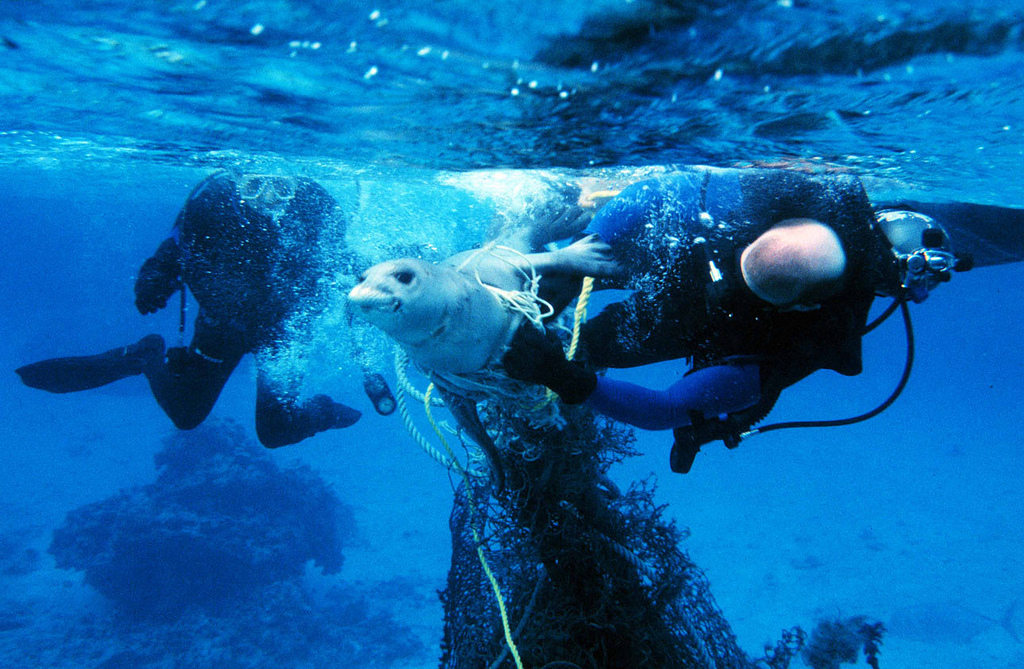
The Sustainable Packaging Coalition recently took a stance against the use of biodegradability additives in petroleum-based plastics. This blog is one in a series of articles about various biodegradability topics and concepts.
Plastic pollution in the ocean is a growing global crisis. It goes by many names; plastic smog, ocean litter, marine debris, and marine pollution are all terms to describe the estimate that eight million tons of plastic find a way into the oceans every year, according to Science magazine. That’s as if one garbage truck dumped its contents into the ocean every minute.
Once plastic is in the ocean, the waves churn it, the sun shines on it, and other variables like temperature and oxygen levels cause the plastic to break into pieces. Those pieces get fragmented further, and those get fragmented, and so on; eventually there’s millions, billions, trillions(!) of tiny plastic pieces (called ‘microplastic’).
Microplastic is ingested by hundreds of species of ocean animals, including zooplankton, salmon, seabirds and fish. They ingest it by accident or mistake it for food. Before the plastic even becomes small enough to get inside ocean animals, it can entangle and kill or hurt them. This has serious potential to cause significant harm.

Given these facts, it’s rational to ask, “can we fix this problem by adding something to make plastic biodegradable?” You’d think that this would be a brilliant human solution, to make it all magically dissolve in the seawater! Something called ‘biodegradability additives’ would seem to precisely do that job, but unfortunately, it’s not quite that straightforward.
Biodegradability additives enable or encourage biodegradation of petroleum-based plastic. They are sometimes marketed as a solution to litter, particularly in the developing world. One class of additives (often called “landfill biodegradable additives”) function by encouraging the few types of microbes that naturally biodegrade petroleum-based plastics. The other class of additives (“oxo-degradable” or “oxo-biodegradable”) function, ironically, by expediting the plastic’s ability to fragment into smaller pieces.
Unfortunately, biodegradability additives cannot improve the ocean pollution problem for several reasons. First, plastic products and packaging that contain these additives tend to be marketed as “biodegradable,” but that tells us nothing about the environmental conditions necessary for biodegradation, the time frame necessary for biodegradation, or the impacts that may occur before biodegradation is complete. To make matters worse, the word “biodegradable” on packaging may encourage littering of that material. Further, the additives are designed to work slowly, at best, and still present a significant risk to ocean animals in the interim years before the biodegradation process is complete.
‘Biodegradable’ means something much more limited than what most people would think, and people are more likely to litter items marked as biodegradable.
One problem with biodegradability additives is that the term biodegradable doesn’t often live up to its ideal. The concept of biodegradability suggests that nutrients will harmoniously be given back to the earth at the end of the material’s life — and as the UN points out, there are certainly commercial interests at play in marketing this idea. However, just because something’s called biodegradable, it doesn’t mean it will break down in a reasonable amount of time — especially if it’s in a place it’s not designed to be, such as the ocean.

Biodegradability is a highly relative concept. Most packaging that is designated as “biodegradable” has passed one of several ASTM tests for biodegradability, each of which features unique test conditions designed to mimic parameters at specific environments such as a bioreactor landfill (ASTM D7475) or an anaerobic digester (ASTM D5511)—not to be confused with compostability standards, which are different and more stringent.
These are very different environments, in terms of heat, oxygen and other factors, than a place like Lake Michigan or the Gulf of Mexico. In other words, a material that has passed one ASTM test should not be assumed to be biodegradable in every environment—especially a marine environment. There’s only one standard for biodegradability in the marine environment (which is currently being revised), but petroleum-based plastics with biodegradability additives have been unable to meet that standard. Considering all these variables, the term “biodegradable” as applied to petroleum-based plastics actually means something much more narrow and limited than what most people would probably ever imagine.

Not only do petroleum-based plastics with biodegradability additives fail to meet marine biodegradability standards, but it also makes people more likely to litter something if it’s labeled biodegradable, as Keep America Beautiful discovered in a study in 2009. The UN points out that this behavior allows for the potential for ocean pollution to become worse.
Biodegradability additives do not mitigate harm to ocean animals; they are still subject to serious risk in the time before petroleum-based plastic starts to biodegrade.
Here’s something else to consider: plastics with biodegradability additives are not designed to even commence the biodegradation process for years, sometimes as many as five. Even if these plastics were theoretically able to meet the standard of marine biodegradation (which specifies that at least 30 percent of the material’s carbon content must turn into carbon dioxide within 6 months), the plastic would still present a threat in that interim time to ocean animals through ingestion, entanglement, or potential toxic exposure.
Hundreds of species of ocean animals have been known to become entangled by plastic, such as in fishing nets in the photo below. If biodegradability additives are added to petroleum-based plastic fishing nets as the solution to that problem, it causes people to feel a distorted sense of comfort that could encourage more litter. Besides, if it takes years for the biodegradation process to start anyway, that doesn’t help a seal caught in one of those nets today.

Ocean animals are also found with plastic in their stomachs, causing starvation. If the average lifespan of a salmon is 3 to 8 years, and it could take more than 5 years for a petroleum-based plastic with these additives to biodegrade, that won’t help the salmon who are accidentally eating it and experiencing harm to their bodies during their lifetimes.
Beyond these serious concerns, a limited number of scientific studies have explored whether ocean animals could be subject to potential toxic exposure when plastic gets inside of them. Studies demonstrate that microplastic is a carrier for toxic pollutants in ambient seawater. In one study, twelve seabirds were examined; all twelve had microplastic in their stomachs. When they looked closer, they found PBDEs (flame retardants applied to plastics and textiles) on the surface of the microplastic. Further science is required to explore if and how those toxins carried by plastic have the potential to migrate into the animals’ body tissues.
If future scientific studies confirm that migration of toxins into animal tissue does occur, then the impacts up the food chain could be immense. Bioaccumulation of toxins via microplastic is a theory that is only recently being studied. If real, it could not only have dangerous repercussions for ecologically significant species, but also for the seafood industry and human health.
Reducing the number of years that it takes for a plastic to biodegrade creates a false sense of security and could aggregate the plastic pollution problem facing our world’s waters. For this reason, biodegradability additives for petroleum-based plastic are an ineffective band-aid to the ocean pollution problem.

Instead, what we need are solutions that prevent plastic from becoming litter in the first place. We need solutions that reconceptualize how materials should flow through our society, and how technology and infrastructure can evolve to address these issues. We should develop systems that encourage packaging design to be intimately intertwined with the sourcing of recycled materials and how waste management systems operate. For example, it’s better to design packaging that is easier and more valuable to recycle, so that we can keep materials in perpetual use rather than throwing them away. Related to that idea is the need to encourage our culture to perceive waste as a resource instead of a problem.
The Sustainable Packaging Coalition (SPC) released a position paper outlining the environmental harm that results from these additives.
The SPC seeks to continue the collective work of industry and NGOs to achieve the beneficial end-of-life solutions necessary for the sustainable use of plastics—it’s just that biodegradability additives is not one of them.

